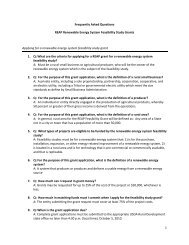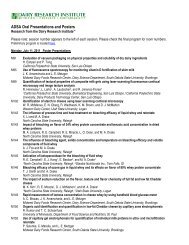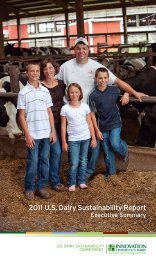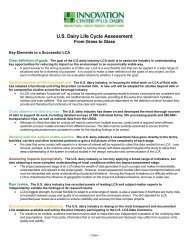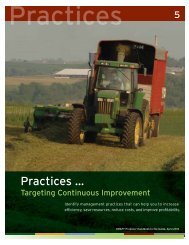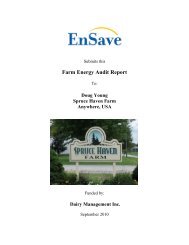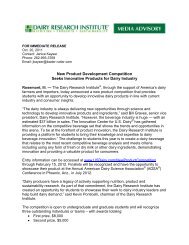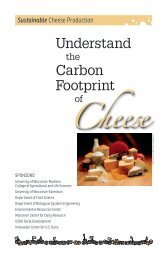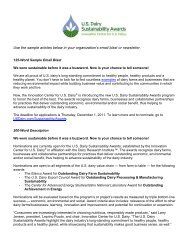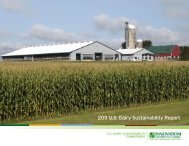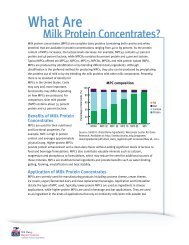Processor Handbook - Innovation Center for US Dairy
Processor Handbook - Innovation Center for US Dairy
Processor Handbook - Innovation Center for US Dairy
You also want an ePaper? Increase the reach of your titles
YUMPU automatically turns print PDFs into web optimized ePapers that Google loves.
Water<br />
Why measure water<br />
Water is a finite resource under increasing pressure from<br />
human activities as well as changing climates. Water use<br />
is directly linked to other local, regional and national<br />
sustainability and environmental impacts. For example,<br />
water availability and quality has implications to human<br />
health, economy, (food) security and ecosystems.<br />
Water management by companies is increasingly important<br />
and includes a variety of practices to reduce the volume<br />
of water used and impacts on water quality. Knowledge is<br />
increasing about safe levels of water withdrawal, efficient<br />
use and water quality management. <strong>Dairy</strong> plants track water<br />
consumption through the use of meters to identify ways<br />
to improve production efficiency. In addition, dairy plants<br />
monitor the quality of water that is leaving the plants.<br />
Scope of the indicators<br />
The water indicators cover the direct water use and water<br />
quality impacts of dairy processing and manufacturing plants.<br />
The indicators should be used to measure and report at<br />
company level, aggregating the totals from facilitates.<br />
Companies should explain if all facilities are included in<br />
the indicators.<br />
Water Use — Primary PM Water 1<br />
1. Relevance<br />
The systematic ef<strong>for</strong>t to monitor and improve the efficient<br />
use of water in the company is directly linked to water use<br />
costs. Total water use can indicate the level of risk posed by<br />
disruptions to water supplies or increases in the cost<br />
of water. Clean freshwater is becoming increasingly<br />
scarce, and can impact production<br />
processes that rely on large volumes of<br />
water. In regions where water sources are<br />
highly restricted, the company’s water<br />
consumption patterns also can influence<br />
relations with other stakeholders.<br />
This indicator can be used to report to GRI<br />
G3.1 EN8.<br />
2. Metric<br />
Total water use as percentage withdrawn<br />
and consumed by source<br />
3. Calculation and reporting<br />
3.1 Measure<br />
Assess the total volume of water<br />
withdrawn and consumed from any water<br />
source that was either used directly<br />
by the company or provided through<br />
intermediaries such as water utilities. This<br />
includes the abstraction of cooling water.<br />
3.2 Report<br />
Report the total volume of water use in percentages by the<br />
sources <strong>for</strong> the company per year in the Water Use Table.<br />
Water Use from Source<br />
4. Optional measurement considerations<br />
None<br />
5. Definitions<br />
Total water withdrawal: It is the sum of all water used<br />
within the boundaries of the reporting organization<br />
from all sources (including surface water, ground water,<br />
collected rainwater and municipal water supply) <strong>for</strong> any<br />
use over the course of the reporting period. Water may be<br />
returned to local sources, but not necessarily in the same<br />
ratio contribution as from the drawn sources (GRI 3.1, with<br />
additions). If a municipality is involved, in<strong>for</strong>mation about<br />
the supply source will need to be collected and included<br />
in the water accounting. Water provided by a municipality,<br />
but not listed elsewhere in the reported water use as being<br />
derived from a specific source remains classified as the<br />
municipal water supply.<br />
Total water consumption: It is the sum of all water used<br />
within the boundaries of the company from all sources<br />
(including surface water, ground water, collected rainwater<br />
and municipal water supply) <strong>for</strong> any use over the course of<br />
the reporting period. (GRI G.3.1)<br />
6. Documentation<br />
In<strong>for</strong>mation on water use can be obtained from water<br />
meters, water bills, calculations derived from other<br />
available water data or (if neither water meters nor bills or<br />
reference data exist) the company’s own estimates.<br />
7. Resources<br />
• Framework <strong>for</strong> an EPA Safe and Sustainable Water<br />
Resources Research Program, EPA, June 2, 2011,<br />
accessed March 25, 2012, www.epa.gov/research/<br />
priorities/docs/SSWRFramework.pdf<br />
Surface water, including water from<br />
wetlands, rivers, lakes and oceans<br />
Ground water<br />
Rainwater collected directly and stored<br />
by the reporting organization (includes<br />
snow and ice melt water)<br />
Wastewater from another organization<br />
Municipal water supplies or other water<br />
utilities (and source)<br />
Totals:<br />
% of Total Water<br />
Withdrawn<br />
% of Total Water<br />
Consumed<br />
4<br />
31





